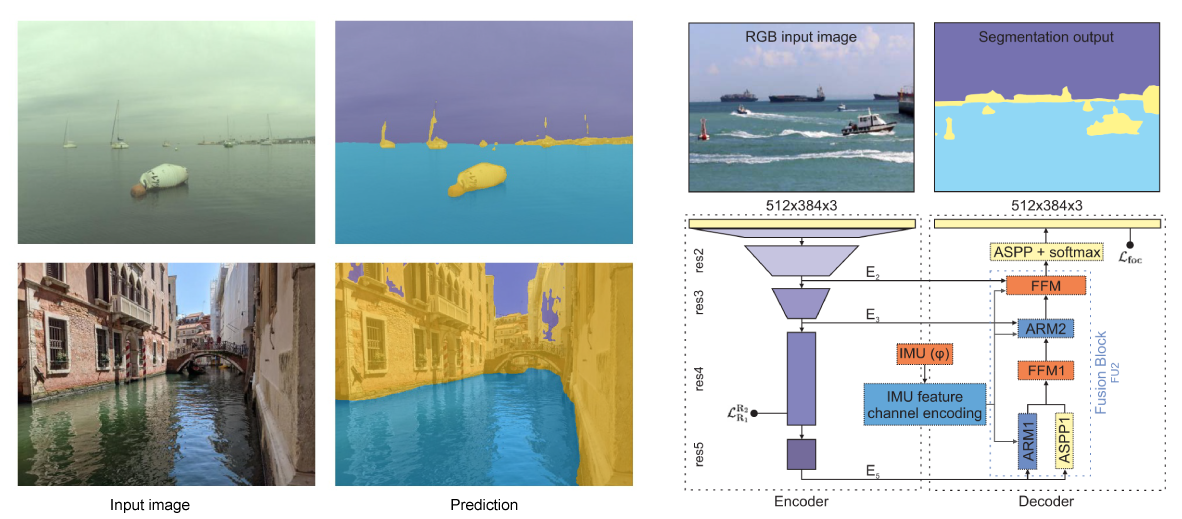PyTorch re-implementation of the WaSR network [1]. Contains training code, prediction code and models pretrained on the MaSTr1325 dataset [2].
- 🌟 [April 2023] eWaSR: An efficient, embedded-compute-ready version of WaSR (new).
- [July 2022] WaSR-T: A temporal (movement-aware) extension of WaSR.
Requirements: Python >= 3.6, PyTorch, PyTorch Lightning (for training and multi-GPU inference)
- Install PyTorch.
- Install the dependencies provided in
requirements.txt.
pip install -r requirements.txtCurrently available pretrained model weights. All models are trained on the MaSTr1325 dataset and evaluated on the MODS benchmark [3].
| model | backbone | IMU | url |
|---|---|---|---|
| wasr_resnet101 | ResNet-101 | weights | |
| wasr_resnet101_imu | ResNet-101 | ✓ | weights |
- Download and prepare the MaSTr1325 dataset (images and GT masks). If you plan to use the IMU-enabled model also download the IMU masks.
- Edit the dataset configuration (
configs/mastr1325_train.yaml,configs/mastr1325_val.yaml) files so that they correctly point to the dataset directories. - Use the
train.pyto train the network.
export CUDA_VISIBLE_DEVICES=0,1,2,3 # GPUs to use
python train.py \
--train_config configs/mastr1325_train.yaml \
--val_config configs/mastr1325_val.yaml \
--model_name my_wasr \
--validation \
--batch_size 4 \
--epochs 50By default the ResNet-101, IMU-enabled version of the WaSR is used in training. To select a different model architecture use the --architecture argument. Currently implemented model architectures:
| model | backbone | IMU |
|---|---|---|
| wasr_resnet101_imu | ResNet-101 | ✓ |
| wasr_resnet101 | ResNet-101 | |
| wasr_resnet50_imu | ResNet-50 | ✓ |
| wasr_resnet50 | ResNet-50 | |
| deeplab | ResNet-101 |
A log dir with the specified model name will be created inside the output directory. Model checkpoints and training logs will be stored here. At the end of the training the model weights are also exported to a weights.pth file inside this directory.
Logged metrics (loss, validation accuracy, validation IoU) can be inspected using tensorboard.
tensorboard --logdir output/logs/model_nameTo run model inference using pretrained weights use the predict.py script. Specify the image directory and IMU directory containing IMU masks (if you use the IMU-enabled architecture).
# export CUDA_VISIBLE_DEVICES=-1 # CPU only
export CUDA_VISIBLE_DEVICES=0 # GPU to use
python predict.py \
--image_dir examples/images \
--imu_dir examples/imus \
--architecture wasr_resnet101_imu \
--weights path/to/model/weights.pth \
--output_dir output/predictionsFor non-IMU versions of the model, no IMU masks are required:
# export CUDA_VISIBLE_DEVICES=-1 # CPU only
export CUDA_VISIBLE_DEVICES=0 # GPU to use
python predict.py \
--image_dir examples/images \
--architecture wasr_resnet101 \
--weights path/to/model/weights.pth \
--output_dir output/predictionsPredictions will be stored as color-coded masks to the specified output directory.
We also provide a script to run the inference on the MODS maritime obstacle detection benchmark [3]. To evaluate your model on MODS follow the steps:
- Download and extract the MODS dataset.
- Run inference using the
predict_mods.pyscript.
export CUDA_VISIBLE_DEVICES=0,1 # GPU(s) to use
python predict_mods.py \
--architecture wasr_resnet101_imu \
--dataset-path /path/to/MODS/ \
--weights output/weights/wasr_rn101_imu.pth \
--output-dir output/mods_predictions/wasr_resnet101_imu- Evaluate using the MODS evaluation toolkit.
Edit theconfigs/mods.yamlin MODS evaluator to link to your root preditions directory (i.e. tooutput/mods_predictionsin this example). Run the evaluation.
# In the MODS evaluator directory
python modb_evaluation.py --workers 8 --config-file configs/mods.yaml wasr_resnet101_imuThis re-implementation was used in the following publication:
Lojze Žust & Matej Kristan. "Learning Maritime Obstacle Detection from Weak Annotations by Scaffolding." Winter Conference on Applications of Computer Vision (WACV), 2022. [arXiv]
If you use this code, please cite our papers:
@InProceedings{Zust2022Learning,
title={Learning Maritime Obstacle Detection from Weak Annotations by Scaffolding},
author={{\v{Z}}ust, Lojze and Kristan, Matej},
booktitle={Proceedings of the IEEE/CVF Winter Conference on Applications of Computer Vision},
pages={955--964},
year={2022}
}@article{Bovcon2021WaSR,
title={WaSR--A Water Segmentation and Refinement Maritime Obstacle Detection Network},
author={Bovcon, Borja and Kristan, Matej},
journal={IEEE Transactions on Cybernetics}
}[1] Bovcon, B., & Kristan, M. (2021). WaSR--A Water Segmentation and Refinement Maritime Obstacle Detection Network. IEEE Transactions on Cybernetics
[2] Bovcon, B., Muhovič, J., Perš, J., & Kristan, M. (2019). The MaSTr1325 dataset for training deep USV obstacle detection models. 2019 IEEE/RSJ International Conference on Intelligent Robots and Systems (IROS)
[3] Bovcon, B., Muhovič, J., Vranac, D., Mozetič, D., Perš, J., & Kristan, M. (2021). MODS -- A USV-oriented object detection and obstacle segmentation benchmark. IEEE Transactions on Intelligent Transportation Systems.



